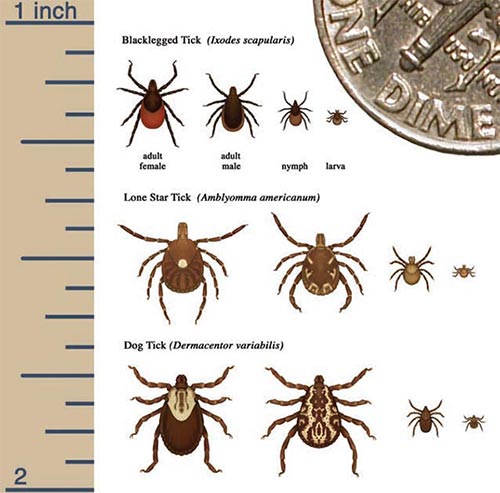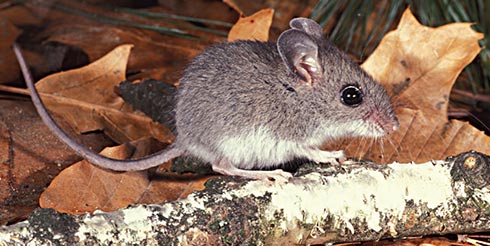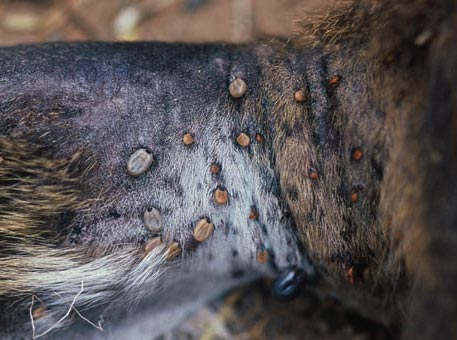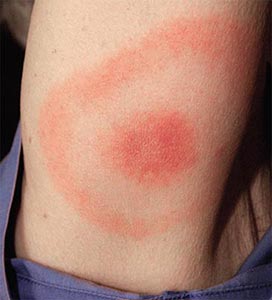_cropped.jpg)
The adult female black-legged tick dwarfs the male. Ticks pictured are enlarged to show detail; actual sizes range from 1/8- to 1/2-inch. Photo by Ken Thomas.
It’s only natural to take a human-centered view of the world. Through this lens, Lyme disease is a ferocious malady that is on the march north. In New Hampshire, researchers recently found that 70 percent of black-legged ticks sampled in Concord were infected with the disease. In Vermont, Lyme disease cases doubled in 2006, then doubled again in 2007. In Maine and New York, annual Lyme infections now number in the hundreds and thousands, respectively.
Lyme disease stories trickle through the media on a regular basis; they make their way through the local bar and around the dinner table. By now you may have heard about the guy down the street who’s had the disease twice. Perhaps you know someone with chronic Lyme disease who’s battled fatigue, Bell’s palsy, or maybe psychosis, for 5, 10, 20 years.
And so it’s only natural to worry. At the very least, after a day in the field, most of us now get head-checks from our friends or partners whenever we feel imaginary ticks crawling through our hair. In more extreme cases, some of us shed all remnants of the “coolness” we worked so hard to foster in high school and unabashedly join the legions who walk around in public with their tube socks pulled up over their pant cuffs.
But there’s also a parallel nature story here, one that's only tenuously connected to human suffering, tube-sock gaiters, or health department statistics. It's a story that involves ticks, deer, and rodents, primarily, but also migratory birds, invasive exotic plants, killer mold spores, and warm winters. And this story starts each June, as the sun dapples the forest floor and tick larvae rise from the detritus to feed.
Lyme disease is, of course, spread to humans by ticks. There are more than a dozen tick species in our northern forests, but only one, Ixodes scapularis, the black-legged tick, transmits Lyme disease.
A black-legged tick begins its life in a honey-colored egg. Each egg is part of a larger egg mass that can contain several thousand individual eggs. These egg masses are hard to see, but you can imagine them as tiny globs, maybe the size of the fingernail on your pinkie finger.
During late spring or summer, a tick larva that is about the size of the period at the end of this sentence will emerge from each egg. The larvae then disperse and travel a short distance in search of blood. Ticks have no eyes; instead, they have photo-receptors at the end of their legs that detect shade and shape. They also sense and seek out sources of carbon dioxide. In fact, because ticks are attracted to CO2, scientists sometimes use dry ice to lure them into collection units.
And so the tick larva waits or shuffles slowly in almost pathetic simplicity, blind, deaf, legs outstretched, as it searches for a passing host. Any warm-blooded animal will do: could be a raccoon, a chipmunk, a grouse. If a host presents itself, the tick larva will latch on, seek a blood vessel, and feed.
This first meal is very important to both the tick and the Lyme disease story, because black-legged ticks are born Lyme-free. They must catch the disease from an infected host.
The infection comes from a spirochete, a microscopic bacterial organism with a worm-like, spiral-shaped form. Many large animals do not carry the Lyme spirochete; and so, if the tick larva feeds on a deer, a raccoon, a skunk, its life may progress without any mention of the disease.
If, however, the tick feeds on a small animal, such as a mouse, a chipmunk, or a shrew, it stands a very good chance of ingesting the Lyme spirochete. These small animals have spent millions of years evolving with the both ticks and the spirochete, which allows them to effectively harbor the disease without catching it themselves. The conventional wisdom has long been that white-footed mice are the primary reservoirs of Lyme disease, but this has been largely disproved in the past five years. Shrews, for instance, are particularly effective hosts, and ticks don’t even require the blood of a mammal – certain ground-foraging birds serve the purpose just as well.
The tick larva spends the first summer and autumn looking for a host. When it finds one, it feeds for two or three days, then drops back to earth and seeks a sheltered spot on the forest floor where it will overwinter. During this period of dormancy, the tick molts into nymph form.
During the nymphal stage, the tick has eight legs and a black shield on its back. It is during this stage that the tick is most dangerous to humans, because it could be Lyme-positive and is very difficult to see. According to data compiled by the Maine Medical Center, tick nymphs begin to emerge from the leaf litter in the Northeast around May 1.
Most nymphal ticks find a meal in June or July. Afterwards, they again retreat to the forest floor, where they molt and re-emerge as adults in the fall. Adult ticks look essentially like bigger versions of nymphs.
As an adult, a tick’s main concern is breeding. To accomplish this, both male and female ticks will climb shrubs or tall grass and wait for a large animal to walk by. This is where deer enter the equation. White-tailed deer are the adult black-legged tick's preferred source of nourishment, and they also serve as a staging area for tick breeding activity.
Once attached to a deer, a female will suck blood for a few days. While she’s fully engorged, a male tick that also happens to be hitchhiking on the deer can find and breed her. Once bred, the female will drop to earth, deposit her eggs in the detritus, and then die. Males also die shortly after copulation.
This whole life cycle can take as little as three months in a laboratory setting, but in nature it usually takes at least two years.
Feeding by Stealth
If you happen to be walking by a black-legged tick in either its nymphal or adult phase, that tick will try to latch on to you and bite you. All of this sounds pretty simple but is really quite complicated. The catch is that ticks need to feed on the sly. If you detect them, you’ll brush them off before they’ve had a chance for a meal. And so they must employ a stealth strategy.
When a tick first breaches your skin, it is not drinking so much as spitting into you. Tick saliva is a veritable cocktail of chemicals – analgesics, anti-inflammatory agents, anti-coagulants – designed to make the bite imperceptible to the victim. Only after the tick has regurgitated enough saliva to numb your senses will it begin to draw your blood and eat it.
While all this is going on, the Lyme spirochete is swimming around harmlessly in the tick’s gut. However, once the first drops of your blood trickle into the gut, the spirochete springs into action. On cue, it migrates through the gut wall and into the tick’s salivary glands and can slide right on into your body.
In most scenarios, a tick must feed for 24 to 48 hours before it can pass Lyme disease on to a human, though it can take even longer. The first symptom of Lyme disease in humans is usually a rash around the tick bite that often, but not always, is in the shape of a bull’s-eye. Along with the rash, many people develop flu-like symptoms.
According to the Infectious Disease Society of America, when Lyme disease is treated quickly with antibiotics, 95 percent of people are cured within a few weeks. If the disease is left untreated, however, the person can be in real trouble. Unlike the flu, which is a relatively predictable, transparent virus, Borrelia burgdorferi is a guerrilla warrior. If not eradicated right away, it can hide in the body for months, even years, and its next attack can take many forms. Advanced Lyme symptoms include rashes, sore joints, headaches, fatigue, loss of memory, heart palpitations, vision trouble, mood swings, psychosis, lockjaw, and meningitis, to name a few. In other words, Lyme disease can masquerade as pretty much any malady out there.
Advanced Lyme disease is so contradictory and confusing that not even the medical community is in complete agreement on the different manifestations of the disease. There are even two sets of guidelines for diagnosis and treatment, one developed by the Infectious Diseases Society of America and one by the International Lyme and Associated Disease Society. If you or someone you know thinks you may have the disease, both you and your doctor should be aware of both sets of guidelines.
Attempts at Control
In the human version of the Lyme story, the next question is how to defeat this thing. But while it’s our way to roll up our sleeves and do battle, the unfortunate fact is that, like so many natural conundrums, Lyme disease is nearly impossible to pin down.
“We can control deer, rodents, and ticks, but unless you take care of all three simultaneously, it’s hard to control Lyme disease,” says Vermont state epidemiologist Patsy Tassler Kelso.
To date, most control measures have been modest in their scale and scope. Some communities have tried treating mice and deer with a topical pesticide. Other measures have been more extreme.
In Monhegan, Maine, the town voted in the late 1990s to remove every single deer on the entire island in an effort to control the disease. This dramatic undertaking was successful and did reduce the tick population. However, deer control efforts in mainland ecosystems have not been as successful. In Freehold, New Jersey, between 2002 and 2005, the town removed roughly half of its deer herd, and it appeared to have no effect on the number of ticks.
Scientists at the Institute of Ecosystem Studies in Millbrook, New York, are currently working on a strain of killer fungus to battle ticks. Rick Ostfeld says that the fungus – the Metarhizium anisopliae strain, if you’re wondering – is a native species that could become a key weapon in the war on Lyme.
“We still have a fair bit of work to do,” said Ostfeld, “but we’ve already seen a lot of promising developments. Right now, we’re trying to beat the drum for more funding.” That drumbeat seems to be going unheeded, however, and Lyme disease research continues to be underfunded.
In the meantime, Ostfeld and his peers are working to understand pulsed resources and their effects on woodland rodent populations. One example of a pulsed resource is an acorn crop. Ostfeld and his colleagues have been working to predict the effect plentiful mast years have on mouse populations, and, in turn, Lyme rates. One of the fascinating things they’ve studied is the relationship between mice and gypsy moths. Ostfeld contends that wherever gypsy moths are at low to moderate levels, mice are the key control agent keeping populations in check. Of course, when mice are thriving, Lyme is thriving. On the flip side, when a mouse population crashes, gypsy moths rise, in turn defoliating a forest. This is bad for the trees and mice, but also bad for ticks, which depend on a moist, leafy forest floor for survival. So it turns out that gypsy moths and B. burgdorferi are natural enemies. How’s that for a pick-your-poison scenario?
A Change in Habitat
From an ecological perspective, the nagging question about Lyme disease remains: why now? Ticks and their hosts have been around the Northeast for thousands of years. And yet, Lyme disease was only officially “discovered” in the mid- to late-1970s.
The historical record suggests that the Lyme spirochete has probably been present in the northeastern landscape for 10,000 years. While it’s impossible to prove this definitively, scientists from Yale University have found B. burgdorferi DNA in alcohol-preserved tick specimens dating back to 1894. Nineteenth century medical records from Long Island, New York, allude to “Montauk knee,” and “Montauk spider bite,” which many feel was, in reality, Lyme disease.
But the dramatic expansion of Lyme disease and black-legged ticks in the last 30 years can be attributed largely to the surge in white-tailed deer populations over the past century. Historians estimate that before European colonization, there were between 24 and 33 million white-tailed deer in what is now the USA, but by the late 1800s, deer were virtually extinct throughout much of the Northeast.

Lifestyle of the Blacklegged Tick: The deer tick’s life cycle usually requires at least two years to complete. Sometime during late spring and summer, tick eggs hatch into larvae. The larvae feed throughout summer and early autumn, then molt into nymphs. The nymphs lie dormant during the winter, then re-emerge the following spring. After finding a blood meal, the nymphs molt into adults that fall. The adult ticks feed and mate on larger animals, particularly deer, then lay their eggs and die. If an adult tick is unable to find a deer in the fall, it will overwinter and resume its quest the spring.
Image from Integrated Pest Management for the Dear Tick, 1993. Carolyn Klass.
Image from Integrated Pest Management for the Dear Tick, 1993. Carolyn Klass.
In the last hundred years, the deer herd has rebounded dramatically. There were, perhaps, a dozen deer left in Connecticut in 1896; today, the population is estimated at over 75,000. In Vermont, the Agency of Natural Resources suggests that deer are more abundant now than at any time in the last 400 years. And so while scientists are loath to go on record with black and white assertions of any kind, it seems very possible that Lyme disease was once prevalent throughout much of the eastern deciduous forest, before being reduced dramatically by the decimation of the deer herd. Now, as the deer return, so too does Lyme disease.
Chuck Lubelczyk with the Maine Medical Center points out that the changing landscape has also contributed to the recent Lyme disease epidemic. “One hundred years ago, most of the region was still in farmland,” said Lubelczyk. “The habitat was essentially one big, open, cleared field, which is not conducive to ticks. With the forest rebounding, deer, mice, and tick populations are all on the rise.”
Lyme disease rates have risen as animal diversity in the Northeast has declined. “Wolves and catamounts were traditional predators that historically kept deer populations in check,” said Lubelczyk. “These days, it’s pretty much only the grill of a Cadillac or a hunter that keeps the population of deer down.”
Mice and rodents have benefited from a similar dilution in both their natural enemies and competition. This idea is the basis of ecologist David Blockstein’s intriguing suggestion that the extinction of the passenger pigeon influenced present day Lyme rates. Blockstein pointed out that 100 years ago, passenger pigeons descended on oaks by the thousands and siphoned off a major part of the mast supply. Today, acorns pretty much fall straight down to waiting mice on the forest floor.
The effects of species diversity on Lyme rates can be seen by comparing the incidence of the disease in the northern U.S. to the southern states.
The black-legged tick is equally prevalent in the north and the south, and yet south of the Carolinas, no more than seven percent of the ticks test positive for Lyme disease, whereas in northern forests, 20-80 percent of ticks are infected. hese numbers can be attributed, in part, to the fact that in the south, lizards are the predominant hosts for tick nymphs. Lubelczyk points out that certain species of lizard are considered “barrier hosts” because they are immune to Lyme infection.
The fragmentation of the northern forests has also helped spread the disease. The suburbanization of our landscape means more people are living in closer proximity to deer, mice, and ticks. It also means more deciduous forest and shrubs, which ticks prefer to denser, coniferous forests.
Invasive exotic plants, another byproduct of suburbanization, seem to promote Lyme disease. Research by the Maine Medical Research Center indicates that the number of ticks doubles in an ecosystem where invasive shrubs such as Japanese barberry and Eurasian honeysuckle exist. These shrubs propagate rapidly due to a lack of natural control factors, creating the kind of dense shelter that is perfect mouse and tick habitat.
Warmer winters have also played a role in northern tick propagation. While the milder winters haven’t affected tick larval emergence one way or the other, the weather has helped populations of mice, deer, and songbirds, which in turn helps the ticks. The warm weather also leads to longer seasonal exposure times for humans, thus increasing our risk of contracting the disease.
Heightened Awareness

To keep black-legged ticks at bay when you head out into the woods, take precautionary measures, such as pulling your socks up over your pant cuffs.
And so the two Lyme stories – the scary statistical one and the interesting biological one – are intertwined. And we humans have to decide just how to correlate everything.
Trish Hanson, an entomologist with the Vermont Department of Forests, Parks and Recreation, remembers doing a lakeside tick-count in northern Vermont. She and many of her fellow scientists ventured afield adorned in improvised bio-hazard suits – duct-tape over their pant and shirt cuffs, hats, gloves – then had a great laugh as they were flagging brush around barely-clad sunbathers who were sprawled out along the water’s edge.
It’s a funny image but also quite evocative. How should we be reacting to Lyme? Certainly no one who reads this magazine is going to stop going out into the woods for fear of the disease, but it’s probably safe to say that most of us are pretty unsettled by the whole specter. We’re used to pills, shots, solutions; we don’t like questions or uncertainty, two traits endemic to all facets of Lyme disease.
“Having had a few close encounters of my own in recent years, I can tell you that my personal and family surveillance has been kicked up a notch,” said Hanson, when I asked her how she was dealing with the issue. She suggested mirrors to help people check hard-to-see spots, and tick repellent in “ticky” areas; basically, she advocated education and common sense.
Rick Ostfeld spoke along similar lines, saying that it’s up to individuals to take personal responsibility. “This is one of those diseases where there’s no vaccine,” said Ostfeld. “We can’t rely on the medical community to protect us, so we’re on our own. We have to educate ourselves; learn about ticks, when they’re out, what they look like. Once you learn this stuff, you’ll know how to be safe.”
Top 5 Lyme Disease Misconceptions
1. While the ticks that carry Lyme disease are commonly referred to as “Lyme ticks” or “deer ticks,” the appropriate scientific name for this tick is the “black-legged tick.”
2. The conventional wisdom holds that the best way to tell the difference between a black-legged tick and a common dog tick is that the black-legged tick is tiny, about the size of a poppy seed, while dog ticks are considerably larger. While it’s true that black-legged tick nymphs are poppy-seed-sized, the adult black-legged ticks can be just as large as their dog tick counterparts. Black-legged ticks can carry Lyme disease in both their nymphal and adult forms, so tick size has no bearing on risk.
3. There are several old-time remedies that suggest the way to deal with ticks is to burn them off or rub them out with peanut butter or petroleum jelly. This is bunk advice. The best way to remove a tick is to use tweezers. Grasp the tick as close to the skin as you can and pull directly back.
4. While the bull’s-eye rash is a sure-fire indication of Lyme infection, sometimes the Lyme rash may be more pedestrian-looking. Tick bites in body crevices (think armpits, toes, elbows) may not develop a distinctive bull’s-eye. And, to complicate things further, according to the Center for Disease Control, 20-30 percent of people infected with the disease never saw a rash.
5. Because overall Lyme disease numbers are highest in Connecticut, Massachusetts, and New Jersey, it is often assumed that people in more northern locales are at less risk of catching the disease. The numbers are less assuring, though, when you put them in a population context. Bennington County, Vermont, for instance, had 33 cases in 2005, which doesn’t sound like much of a problem, but this projects out to a rate of 96 cases per 100,000 people, which is higher than the average incidence rate in Connecticut (52 cases per 100,000 people). Also keep in mind that because Lyme disease is so hard to diagnose, infections are underreported. Some Lyme advocacy groups report that Lyme rates in Connecticut could be as high as 34,000 cases each year. No one is making such a sensational claim in Vermont, but join any International Lyme and Associated Diseases Society web discussion and you’ll find a number of people who argue very eloquently that the actual infection rate is many times higher than what is reported.
Dave Mance III is the editor of Northern Woodlands magazine.














No comments:
Post a Comment